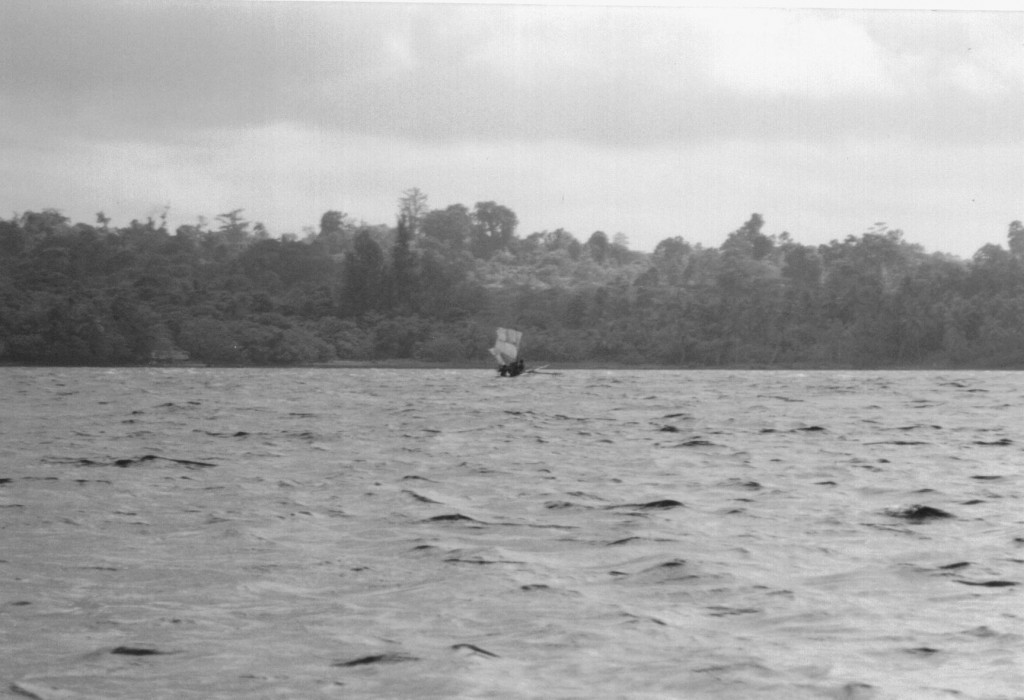By the nonfiction-cryptozoology author Jonathan Whitcomb
Introduction
This is not about details in the form and features of the ropen or about why the sightings in general are not from misidentified birds or bats or about the scientific and philosophical ramifications from a discovery of a modern living Rhamphorhynchoid pterosaur. This is about how to get close enough to a ropen, on Umboi Island, (and under reasonable conditions) to be able to get reasonable photos and video footage of this featherless flying creature.
I led a two-week expedition on Umboi (called by natives “Siasi”) late in the year 2004. I now abbreviate this expedition “WPEU” for Whitcomb-Paina expedition on Umboi (Luke Paina was my native assistant). A few weeks later, after my return to the United States, David Woetzel and Garth Guessman conducted their own expedition on Umboi (late in 2004); Jacob Kepas was their native interpreter. I now call this expedition “WGK.”
Lake Pung on Umboi (crater lake), photo by G. Guessman
Be aware that no expedition on Umboi Island should be undertaken before receiving significant advice from at least one explorer who has been on that tropical island and who has successfully worked with local natives in hiking in the interior. The following ideas about searching for the ropen, or a number of the nocturnal animals, is not advice for going to Umboi Island or advice for how to conduct oneself after arriving there. I take no responsibility for any decisions any other person may make regarding going on any expedition.
Several expeditions on Umboi preceded my own, but their successes were almost entirely with interviewing native eyewitnesses. The native Rex Yapi Epa has been searching for the ropen on Umboi, with his expedition team, in recent months. As of the beginning of 2019, however, nobody has been able to provide the scientific community with any photo or video footage of a ropen on this remote jungle island, at least not to my present knowledge.
I now emphasize that any or all of the following pieces of advice may be dangerous to life and limb, for anyone who follows any of my advice. I take no responsibility for any result, or lack of result, related to the following.
Off the southern coast of Umboi Island (WPEU expedition, 2004)
I will not go into details about why I offer the following pieces of advice, although I may later publish another blog post with such explanations.
Search Possibility #1
Camp out near Lake Pung, either on or near the shore or on the lookout point where Woetzel and Guessman camped in 2004. Some members of the expedition team will need to be there continuously for at least two weeks. This can get boring, so you might want to rotate this watch between members of your expedition team.
Every day, during those 14+ days near Lake Pung, get your cameras and video camcorders ready, including taking the lens caps off each lens and turning the power on for each device. Every day, go through the same routine, or keep to it as closely as reasonably possible:
Pick a spot on the shore of the lake, to begin the routine. Have every person present yell moderately loudly (not as loud as possible) for about 20-40 seconds, always keeping a watch for a ropen that might fly out of the jungle somewhere (anywhere).
Walk about a third of the way around the shore of Lake Pung, if possible. Repeat the 20-40 seconds of yelling. Walk a similar distance around the lake and repeat that, but each time, at each location, shout a little louder.
The above routine should be followed at least three times a day, with each yelling session starting at moderately loud and ending (at a different part of the lake shore) very loudly. Remember to keep the cameras completely ready to record at each time that the people shout.
Those three times should be something like this:
- About an hour after sunrise
- At about midday
- About two hours before sunset
If possible, don’t skip even one day with this routine, and keep it up for at least fourteen days.
For the next search possibility, I’ll write another blog post.
###
.
Some of the names for this creature [in Papua New Guinea] are as follows: seklo-bali, ropen, duwas, kor, wawanar.
.
Jonathan Whitcomb answers many questions from a high school student who wanted to write a novel about the ropen of Umboi Island.
.
The ropen is a modern Rhamphorhynchoid pterosaur, the long-tailed type that is sometimes labeled “basal.”
.
It’s a short cryptozoology book about apparent living pterosaurs. Let’s begin with a list of some of the benefits available to young readers, for this is for kids and teenagers . . .
.
Is the ropen a modern pterosaur?
What is this flying creature called “ropen?” Countless eyewitnesses, in many countries across the planet, have pondered what it was they had seen. But ropens continue to fly overhead, continuing to shock humans who had assumed that all pterosaurs had become extinct millions of years ago.
.
The crater lake where seven native boys were terrified at the appearance of the huge ropen (at midday, late 1993 or early 1994)
.





One Reply to “How to Find the Ropen of Umboi”
Comments are closed.